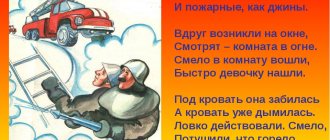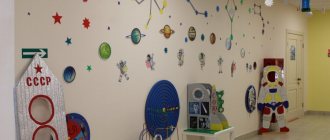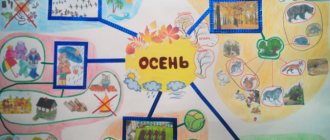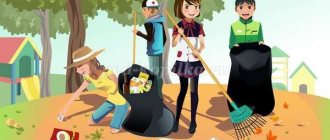An open comprehensive lesson in a preparatory group on the topic: “It’s so cool in space!”
An open comprehensive lesson in a preparatory group on the topic: “It’s so cool in space!”
Author: Galina Aleksandrovna Malyshkina, teacher at the Municipal Administrative Educational Institution No. 90 in Tyumen
Program content:
Introduce children to the concept of the solar system. Expand children's knowledge about planet earth. Talk about how people used to imagine our planet – Earth. To develop in children the ability to form adjectives from nouns, to depict objects by representation, to create a composition on a wide expanse of the sky. To consolidate children's knowledge about the structure of the solar system and cosmic phenomena; concepts of “stars”, “planets”, “comets”, “satellites”, names of planets, the ability to answer a teacher’s question with a complete answer. Develop the skill of reading syllables and words, thinking, attention, memory, articulatory apparatus, artistic and creative abilities: freely experiment, imagination and sense of composition. To cultivate independence, activity, cognitive interests, neatness, a sense of camaraderie, the ability to listen to the teacher and comrades, the desire and ability to work in a team.
Preliminary work:
Examination of illustrations on the theme “Space”, conversation about space; viewing illustrations about space; drawing “Space Fantasy”, starry sky, reading poems and stories about space.
Materials and equipment:
Tinted sheets of blue A-4 paper, napkins, stacks or plastic sticks, flat stars, phonogram of a space rocket launch; cards with words with missing letters; star drawing for eye gymnastics; flour, tray, multimedia system, didactic game “Cut pictures”.
Progress of the lesson:
– Guys, many guests came to our lesson today. Let's say hello to them.
- Hello.
- Guys, what are your mood today?
- Good, joyful, cheerful.
- Let's hold hands and convey our good mood to each other.
All the children gathered in a circle.
I am your friend and you are my friend.
Let's hold hands tighter
And let's smile at each other.
- Fine. Listen to what the next poem is about.
A steel ship flies in space around the Earth. And even though its windows are small, everything is visible in them as if on the palm of your hand: the expanse of the steppe, the surf, and maybe you and me too!
- Tell me guys, what did I read the poem about now? Soon our country o. It's 55 years since the first man flew into space. This is a holiday of astronauts and people who participate in the creation of space rockets. Would you guys like to become astronauts? Who are astronauts? What do you think an astronaut should be like? (healthy, strong, knowledgeable, hardworking, courageous, resilient, etc.).
– Today we will have an unusual activity: you and I will fly into space.
To find out what we will take on the journey, let's solve the riddle.
A bird cannot reach the moon
Fly and land on the moon.
But he can do it
Do it fast...(rocket)
- That's right, guys, we'll fly on a rocket. So, we will soon go on a space journey to the planets of the solar system. But first, let's do some gymnastics for our tongues. To give clear answers, we need to train our tongues.
Chu-chu-chu, I want to fly into space.
To them - to them - to them, we'll fly on a rocket.
Dy-duh-duh, we'll fly to the star.
Oh - oh - oh, then we'll return home.
- Well done, everyone completed the task, took their places, and prepared for the start.
(Sound of a rocket launching).
So, we set off on a space journey to the planets of the solar system.
– Look at the screen - what our planet looks like in outer space. (Slide show).
– In ancient times, people believed that the Earth was huge and flat, like a plate, and that you could reach the edge of the Earth. There were even daredevils who dreamed of getting to this edge and seeing what was there at the edge of the Earth and whether it was possible to fall from it. They set off on foot or on horseback or by ship. Those people who traveled on foot or on horseback sooner or later reached the big water and believed that this was the end of the Earth, and their journey ended. But there were also those who, having reached the shore, boarded a ship and continued their journey; they were convinced that when you set off from some place and always move in the same direction, you return to where you started your journey. Then they realized that the Earth is not flat like a pancake, it is round like a ball.
– Scientists have found that our planet is not alone in the solar system. What is the solar system?
D.: This is the sun - around which nine planets, many small planets - asteroids and comets - revolve.
What planets do you know? (Children list).
– Guys who want to talk about the planet:
Mars?
Jupiter?
Saturn?
Poems about the solar system
Elusive, little Mercury is the first to meet solar storms. The second, behind him, flies Venus With a heavy, dense atmosphere. And the third, the carousel spins, Our earthly cradle. The fourth is Mars, the rusty planet, the red-orange one. And then they rush, like a swarm of bees, the asteroids in their orbit. The fifth is Jupiter, very large and clearly visible in the starry sky. Sixth - Saturn, in chic rings, Charming, under the rays of the sun. The seventh - Uranus, lay down like a couch potato, Because his long path is difficult. The eighth is Neptune, the fourth gas giant. He is a dandy in a beautiful blue shirt. Pluto, Charon, ninth in the system, pass the time in the darkness as a duet (Author unknown)
Mercury
Look! Do you know who this wanderer is? It is called by the name of God - the messenger. The closest planet to the Sun - Let's get acquainted - is Mercury. He loves to hide in the rays Faster than anyone else and very strongly From the heat in solar ovens The surface is hot for a long day. From the wind of the Sun there is only the atmosphere. And where the kingdom of dark night is, the temperature stays at about minus two hundred. By the way, it looks like a double of the Moon, a neighbor. The landscapes around us are familiar, Meteorites often fall, and the composition of the soil is even similar. (Author unknown)
Venus
Very close to us, but still Venus looks down at us from an utter height. This planet is named after the goddess of beauty. Although it has a beautiful name and a pleasant appearance - the Planetary spirit of Venus, due to the dense atmosphere, is scary, menacing and angry. There are winds, clouds and acid rain everywhere, Hurricanes and volcanoes, Through the valleys and mounds. The heat swirls in circles there... The days there are very long. And Venus is visible in the morning as a very bright star, hanging above the horizon and looking at you and me. (V. Berendeev)
Earth
There is one garden planet in this cold space. Only here the forests are noisy, calling migrating birds, only here Lily of the valley blooms in the green grass, And only here are dragonflies looking into the river in surprise... Take care of your planet - After all, there is no other like it! (Roman Sef)
Moon
Faithful companion, night decoration Additional lighting. Of course, we must admit: The Earth would be boring without the Moon! (V. Aldonina)
Mars
The fourth is Mars, red-orange, Wandering in the sky along the ecliptic constellations. Two tiny satellites, discovered once, Under the names: Phobos, Deimos - as retribution Two times smaller than Venus And the gravitational force is small The compositions of the atmosphere are similar, But it is very rarefied And rarely completely transparent From long dust storms and light clouds. There are riverbeds that have long been lost. Volcanoes are sleeping, mountains have risen high, Less heat from the Sun - and the water has frozen in permafrost. Twice: its path is longer, years. But the days are counted like on Earth. (Author unknown)
Jupiter
The fifth name of the Universal ruler and the Roman king of the gods is called Jupiter. Jupiter is very, very big And moons over sixty have already been discovered. The cosmic swallows garbage well. It has three elite rings. More massive than satellites and planets at once. Rotates quickly with colored clouds. And sometimes “super lightning” will trace a trail. Has strong magnetic fields. Built like a layered ball of gases and a solid inner core. Let's look through the telescope and see right away the Centennial Whirlwinds, the Red House. And to the satellites discovered by Galileo: Callisto, Io, Ganymede, Europa, space probes flew long ago, and laid paths through space. After Venus, Jupiter appears in our sky as the brightest of all the stars. I was a little short in size And I didn’t have the time to become a star. (Author unknown)
Saturn
Each planet has something of its own, which most clearly distinguishes it. You will certainly recognize Saturn by sight - it is surrounded by a large ring. It is not continuous, it is made up of different stripes. Here's how scientists solved the question: Once upon a time, water froze there, And Saturn's rings were made of snow and ice. (Rimma Aldonina)
Neptune
Neptune in blue radiance - “sea deity” Found, in calculated coordinates, - Halle. The calculations of Adams and Le Verrier became a triumph for all whose works revealed the laws of heaven. The eighth from the Sun, thirty times further than our Earth. Much denser, among the giant planets. Thirteen companions are known from his family, He is in rings made of dust particles, elegant. Methane atmosphere, winds, clouds, One of the satellites, in reverse motion, With the surface only slightly covered with nitrogen It is clear what gravity was enough for. (Author unknown)
– Are there any other objects in outer space besides the planets of the solar system? (Comets, meteorites, asteroids, stars, satellites, rockets, constellations). The sky above our head is strewn with many stars. They look like small sparkling dots and are located far from the Earth. In fact, the stars are very large (slide show). And then one day, a man was looking at the starry sky, and he wanted to know what kind of stars they were and why they were so bright. Scientists came up with special instruments - telescopes, through which they observed space, stars, planets, etc. (slide show).
– Are the stars in outer space located separately or forming some kind of groups? What are their names? (Constellations)
– What constellations do you know? (Children's answers).
– Each of you was born under some constellation. (Children name what constellation they were born under.) What is the biggest star you know? That's right, the sun is the largest and hottest star in our solar system. You can’t look at her with open eyes for long. Let's do some gymnastics for the eyes so they can rest.
- Let's draw a star with our eyes.
What other planets do you know? (Children list).
– To fly further, we need to complete the following task. You need to fill in the missing letters in the names of the planets.
(children write in.)
VEN...RA
YUP...TER
MA...S
...LUTON
NEPT...N
– People have not yet reached the stars, but they have already studied the planets. As you have already said, the surface of the planets consists of craters. Want to see how they are formed?
Experience: “Meteorites and meteorite craters”
– Imagine that the flour is the surface of the planet, and the ball is a meteorite. A meteorite flies through space at tremendous speed and hits the surface of the planet. Look at what has formed on the surface of the planet - depressions, holes, craters. Guys, why did the crater form? (The meteorite is heavy, and the surface of the planet is soft, covered with a thick layer of dust, so the crater was formed).
– People wanted to know if there was life on other planets. What creatures live there, are they similar to us, is there air on other planets. But to find out, you must fly to them. Airplanes were not suitable for this. Who knows why? (because the planets are very far away). And so scientists, under the leadership of designer Korolev (slide show), invented the first satellite, installed instruments on it and launched it into outer space. There were two dogs on board - a squirrel and an arrow, they successfully returned to Earth. And then on April 12, 1961, a man went into space for the first time. Who was the first astronaut on Earth? (slide show). When Yuri Gagarin flew into space for the first time, the whole country watched his flight, all the people were worried. And when he landed, everyone rejoiced. People took to the streets of cities and celebrated. We were all proud that it was a Russian citizen who was the first in the world to fly into space.
- And now you and I will draw. But we will draw in an unusual way: on special sheets that we have already prepared in advance. We will scratch the drawing with sharp sticks. This image method is called grattage or in other words, scratches. It will take some effort to scratch and paint your design. We will draw space and everything connected with it. Think over the content and composition of your idea of space, highlight the main and minor elements and get started. In order for some objects (comets, planets, the moon) to appear more voluminous, you need to completely scratch the entire surface inside the outline.
As the work progresses, I collect children's drawings and place them on the board.
When almost all the children have completed the task, a soundtrack of calm music is turned on.
Physical education minute:
– What wonderful music it sounds, it is calm, slow, quiet. I just want to soar above the Earth, fly in outer space. In space there is weightlessness and all movements are smooth and slow. Let's imagine that we are in outer space.
To the accompaniment of slow music, children imitate the movements of astronauts in outer space.
It's so cool in space!
Stars and planets
In black weightlessness
Slowly swimming!
- Look, guys, each of you has a star on the tray. You should give this star as a gift and stick it on the drawing that you liked best. Look carefully at the pictures. Choose the one you like and glue your star on it.
One child does a verbal analysis of the work, and then the children take turns going to the board and sticking a star.
(this is how children perform visual analysis of a drawing)
– Our journey has come to an end. Let's once again, like real astronauts, spend a few minutes in zero gravity.
Relaxation with calm music.
| Tweet |
| Like |






